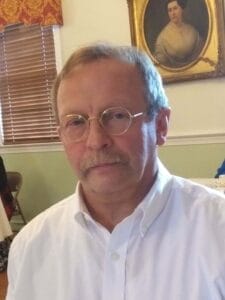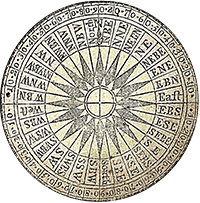
The famed historian, John Filson, wrote about Daniel Boone’s fantastic frontier experiences. Daniel’s popularity was also boosted to subsequent generations by Fess Parker’s portrayal in the Disney series, Daniel Boone.
Whether you are studying Squire Boone Jr.s activities as a gunsmith, businessman, carpenter, Indian fighter, pastor, politician, or frontiersman, he was a man of accomplishment. I am sharing a timeline of events in his life…
A Squire Boone Jr. Timeline
1744 Squire Boone Jr. (the subject of this timeline) was born on October 5th, to Squire and Sarah Boone in Berks County, Pennsylvania. He was younger than his famed brother, Daniel Boone by ten years.
1747 At age five, his family relocated to the Shenandoah Valley, near Winchester, Virginia.
1749 His family again relocated … this time to the Yadkin Valley in Rowan County, North Carolina.
1759 At age 15, Squire was sent back to Pennsylvania to apprentice as a gunsmith under his cousin Samuel Boone.
1764 After completing apprenticeship, he returned to his family in North Carolina.
1765 Squire Boone and Jane Van Cleave married on August 8th.
1765 Later in the year, Squire, Daniel, and three others trekked to Florida. They did not think the land they saw (near the Altamaha River) was suitable for settlement and returned home.
1766 A son, Daniel, is born to Squire and Jane.
1766 A son, Jonathon, is born to Squire and Jane. (I do not know if Daniel and Jonathon were twins)
1767 A daughter, Jane, is born to Squire and Jane.
1769 A son, Moses was born to Squire and Jane.
1769 In November, Squire volunteered to search for his brother Daniel and brother-in-law John Stewart who had not returned from an exploratory trip to Kentucky. He was accompanied in this search by Alex Neely. Squire eventually found his brother Daniel. The brothers decided to hunt thru the winter. Neely does not want to winter in Kentucky and starts the trek back to North Carolina.
1770 In late spring Daniel told Squire he decided to stay in Kentucky. Squire decided to return to North Carolina. They make a pact to meet, defining the location and date. On his return trip to North Carolina, Squire was robbed by Indians of the pelts and he and Daniel collected. Squire returned to North Carolina unharmed and let the families know Daniel was alive.
1770 Squire battled Indians on the headwaters of the Clinch River.
1772 A son, Isaiah, is born to Squire and Jane.
1773 Squire battled Indians in Powell’s Valley when the settlers were ambushed.
1764 A daughter, Sarah, is born to Squire and Jane.
1775 Squire battled Indians at Twetty’s Fort battle.
1775 In May, as part of Kentucky’s first legislature, Squire Boone introduces a bill to preserve the range.
1775 Squire was among the thirty men led by Daniel Boone that blazed the Wilderness Road. This road led from the Cumberland Gap into what is now Madison County. The group assembled a log fort and named it Fort Boone. It later became known as Boonesborough.
1776 A daughter, Elizabeth, is born to Squire and Jane.
1776 On August 7th, Parson Squire performs the first marriage west of the Appalachian Mountains when he performed marriage service for Samuel Henderson and Elizabeth Calloway.
1777 A son, Enoch, is born to Squire and Jane.
1777 Squire battled Indians at Harrod’s Fort. This battle included hand to hand combat.
1778 Squire battled Indians at Fort Boonesborough in 1778. This battle included hand to hand combat. Simon Girty was present at the siege.
1779 A daughter, Rachel, is born to Squire and Jane.
1779 After the siege of Boonesborough, Squire moved his family to the settlement that eventually became Louisville. He brought 13 families to Shelby County and built Squire Boone’s Station. The station also was known as Painted Stone. Squire battled Indians here.
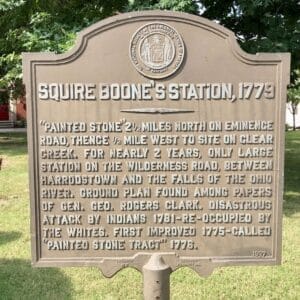
1780 Parson Squire Boone delivered the first sermon at Painted Stone. The Painted Stone area is part of modern Louisville Ky.
1781 A wounded arm in April during an Indian attack on Painted Stone left Squire’s right arm an inch and a half shorter than his left arm. The settlers abandoned the station and headed for nearby Linn’s Station. Squire was injured and could not make the trip, so he and his family stayed behind. Those bound for Linn’s Station were attacked and many were killed. There were few survivors.
1782 Squire battled Indians at Painted Station.
1782 Squire lost much of the land he had claimed while working for wealthy land speculators and was forced to settle elsewhere in the county.
1785 A daughter, Mary, is born to Squire and Jane.
1787 Squire lost more land. He and Samuel Boone, his cousin, head south to start a settlement near Vicksburg Mississippi. They were met by hostile Indians. They then traveled to New Orleans and opened a gun shop.
1790 The Spanish Government closed the gun shop and confiscated his inventory. Squire then returns to Kentucky.
1790 Squire served in the Virginia Legislature. It met in Richmond Virginia. He was the primary sponsor of primary sponsor of the bill to charter the town of Louisville.
1799 Squire and Daniel Boone move to Missouri. Squire stays a few years then returns home with one of his sons. When he arrives in Kentucky, he learns that his remaining land has been lost to land sharks and back taxes.
1804 Squire settled south of Corydon Indiana about 1804. His cousin Samuel settles nearby.
1809 Squire established Boone’s Mill and opened it for business.
1813 Two years before his death, Squire built the first Baptist Church in the State of Indiana with the help of one of his sons.
1815 August 15, Squire Boone Jr. died. His sons buried him in a cave
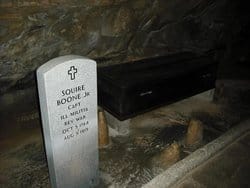 on his property where he had once hid from hostile Indians. The burial cave of Squire Boone was sealed by his sons and his remains were left undisturbed for many years; but in the mid-20th century, relic hunters began taking parts of his coffin and even some of his bones. The cave eventually became a commercial attraction (Squire Boone Caverns) with guided tours. According to Boone Cavern staff, Squire Boone’s remains were placed into a new coffin (circa 1973) which can be seen at the end of the cavern tour.
on his property where he had once hid from hostile Indians. The burial cave of Squire Boone was sealed by his sons and his remains were left undisturbed for many years; but in the mid-20th century, relic hunters began taking parts of his coffin and even some of his bones. The cave eventually became a commercial attraction (Squire Boone Caverns) with guided tours. According to Boone Cavern staff, Squire Boone’s remains were placed into a new coffin (circa 1973) which can be seen at the end of the cavern tour.
Squire was severely wounded eleven times, and he carried many of those injuries with him for life. While he is sometimes 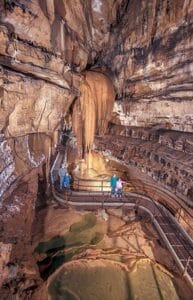
If you are within traveling distance, I hope that you have the opportunity to visit Squire Boone Caverns.
Sources: Wikipedia, The Incredible Adventures of Daniel’s Kid Brother, Squire (Conway), Familysearch.com, Squire Boone (Jillson), and squireboonecaverns.com (site photos used with permission).
Welcome to “Sharing the Stories of History with Tim Mann”!
Meet Timothy A. Mann, a passionate historian born and raised in the heart of Shelby County, Ohio where Tim’s roots run deep in the rich soil of American history. As the author of articles and books, including “Frontier Miscellany Concerning the Miami County Ohio Militia,” “Colonel John Mann, His Kith and Kin,” and “Frontier Militia – The War of 1812,” Tim’s literary contributions have enlightened and inspired countless history enthusiasts.
Join Tim Mann on a journey through time as he shares fascinating tales, untold stories, and hidden gems from the annals of history. Let’s delve into the past together and uncover the wonders that await in “Sharing the Stories of History with Tim Mann.”

